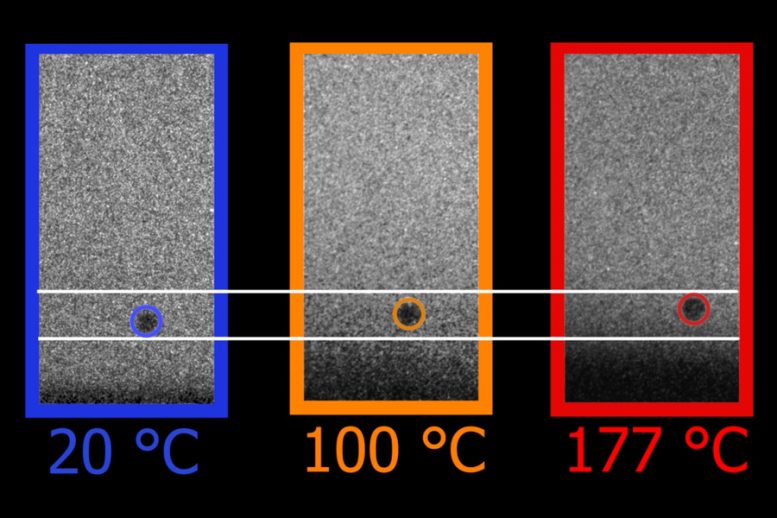博文
麻省理工学院的科学家发现极端条件下惊人的金属行为
||
麻省理工学院的科学家发现极端条件下惊人的金属行为
诸平
据美国麻省理工学院(Massachusetts Institute Of Technology简称MIT, Cambridge, MA, USA)2024年5月31日提供的消息,麻省理工学院(MIT)的科学家发现了极端条件下惊人的金属行为(“Counterintuitive” Findings: MIT Scientists Uncover Surprising Metal Behavior Under Extreme Conditions)。
麻省理工学院的科学家们发现,像铜这样的金属在高速加热和撞击时会变得更强,这挑战了传统的观点,并有可能成为太空和高速制造等极端环境中的增强材料。
金属被加热后会变得更软,这就是铁匠如何将铁加热到红色的温度,使其形成复杂形状的原因。任何将铜线与钢制衣架进行比较的人都会很快发现,铜比钢柔韧得多。
但麻省理工学院(MIT)的科学家们发现,当金属被以超高速运动的物体撞击时,情况正好相反:金属越热,强度越大。在这些条件下,金属承受着极大的压力,铜实际上可以和钢一样坚固。这项新发现可能会为极端环境设计材料带来新的方法,比如保护航天器或高超音速飞机的盾牌,或者用于高速制造过程的设备。相关研究结果于2024年5月22日已经在《自然》(Nature)杂志网站发表——Ian Dowding, Christopher A. Schuh. Metals strengthen with increasing temperature at extreme strain rates. Nature, 2024. DOI: 10.1038/s41586-024-07420-1. Published: 22 May 2024. https://www.nature.com/articles/s41586-024-07420-1
参与此项研究的除了来自MIT的研究人员之外,还有来自美国西北大学(Northwestern University, Evanston, IL, USA)的研究人员。此文由麻省理工学院研究生伊恩•道丁(Ian Dowding)和前麻省理工学院材料科学与工程系(MIT’s Department of Materials Science and Engineering)主任、现任美国西北大学(Northwestern University)工学院院长、麻省理工学院客座教授克里斯托弗•舒赫(Christopher A. Schuh)共同撰写。
反直觉的结果和潜在的应用(Counterintuitive Results and Potential Applications)
作者写道,这项新发现是违反直觉的,与几十年来在不那么极端的条件下进行的研究不一致。这些意想不到的结果可能会影响到各种应用,因为这些撞击所涉及的极端速度经常发生在轨道上的陨石撞击航天器以及制造、喷砂和一些增材制造(additive manufacturing)—3D打印(3D printing)—工艺中使用的高速加工操作中。
研究人员用来发现这种效应的实验包括将直径只有百万分之一米的蓝宝石微粒射向平坦的金属薄片。在激光束的推动下,粒子达到了很高的速度,大约是每秒几百米。虽然其他研究人员偶尔也做过类似的高速实验,但他们倾向于使用更大的撞击器,在厘米或更大的尺度上。因为这些较大的撞击主要是由撞击的冲击作用所主导的,所以没有办法将机械和热效应分开。
新研究中的微小颗粒在击中目标时不会产生明显的压力波。但麻省理工学院花了十年的时间研究,才开发出以如此高的速度推动这种微观粒子的方法。克里斯托弗•舒赫说:“我们已经利用了这一点,以及其他观察高速撞击本身的新技术。”
观察和发现(Observations and Findings)
他说,研究小组使用了极高的高速摄像机“来观察粒子的进入和离开。”当粒子从表面反弹时,入射和射出速度之间的差异“告诉你有多少能量沉积”在目标上,这是表面强度的一个指标。
伊恩•道丁说,他们使用的微小颗粒是由氧化铝或蓝宝石制成的,“非常坚硬。”直径在10~20 μm之间,是人类头发直径的十分之一到五分之一。当这些粒子后面的发射台被激光束击中时,部分材料蒸发,产生一股蒸汽射流,将粒子推向相反的方向。
研究人员将这些粒子射向铜(Cu)、钛(Ti)和金(Au)的样品,他们希望他们的结果也适用于其他金属。他们说,他们的数据首次提供了直接的实验证据,证明了这种异常的热效应,即随着热量的增加,强度也会增加,尽管之前已经有过关于这种效应的报道。
根据研究人员的分析,这种令人惊讶的效果似乎是由组成金属晶体结构的有序原子阵列在不同条件下移动的方式产生的。他们表明,有三种不同的影响控制着金属在压力下的变形,其中两种影响遵循在高温下增加变形的预测轨迹,而第三种影响,称为阻力强化(drag strengthening),在变形率超过一定阈值时逆转其影响。
阻力强化效应 (Drag Strengthening Effect)
在这个交叉点之外,温度越高,材料内声子(phonons)的声波或热波的活动就会增加,这些声子与晶格中的位错相互作用,从而限制了它们滑动和变形的能力。伊恩•道丁说,这种效应随着撞击速度和温度的增加而增加,所以你的“速度越快,位错的反应就越小。”
当然,在某一点上,升高的温度会开始熔化金属,在那一点上,效果会再次逆转,导致软化。伊恩•道丁说,这种强化效应“是有限度的,但我们不知道它是什么。”
克里斯托弗•舒赫说,这些发现可能会导致在设计可能遇到这种极端压力的设备时选择不同的材料。例如,通常较弱但较便宜或较容易加工的金属,可能在以前没有人想到使用它们的情况下很有用。
研究人员研究的极端条件并不局限于航天器或极端的制造方法。伊恩•道丁说,“如果你在沙尘暴中驾驶直升机,很多沙粒在撞击叶片时会达到很高的速度,”在沙漠条件下,它们可能会达到高温,这时这些硬化效应就会开始发挥作用。
研究人员用来揭示这种现象的技术可以应用于各种其他材料和情况,包括其他金属和合金。他们说,通过简单地从不太极端的条件下的已知特性推断来设计用于极端条件下的材料,可能会导致对材料在极端应力下的表现的严重错误的预期。
这项工作得到了美国能源部(US Department of Energy)、科学办公室(Office of Science)、基础能源科学办公室(Office of Basic Energy Sciences)、材料科学与工程部门(Division of Materials Sciences and Engineering)的支持(US Department of Energy, Office of Science, Office of Basic Energy Sciences, Division of Materials Sciences and Engineering under award no. DE-SC0018091)。
上述介绍,仅供参考。欲了解更多信息,敬请注意浏览原文或者相关报道。
The strength of materials depends on the rate at which they are tested, as defects, for example dislocations, that move in response to applied strains have intrinsic kinetic limitations1,2,3,4. As the deformation strain rate increases, more strengthening mechanisms become active and increase the strength4,5,6,7. However, the regime in which this transition happens has been difficult to access with traditional micromechanical strength measurements. Here, with microballistic impact testing at strain rates greater than 106 s−1, and without shock conflation, we show that the strength of copper increases by about 30% for a 157 ℃ increase in temperature, an effect also observed in pure titanium and gold. This effect is counterintuitive, as almost all materials soften when heated under normal conditions. This anomalous thermal strengthening across several pure metals is the result of a change in the controlling deformation mechanism from thermally activated strengthening to ballistic transport of dislocations, which experience drag through phonon interactions1,8,9,10. These results point to a pathway to better model and predict materials properties under various extreme strain rate conditions, from high-speed manufacturing operations11 to hypersonic transport12.
https://wap.sciencenet.cn/blog-212210-1436517.html
上一篇:新的研究证实,这种神奇的药物可以降低老年人的死亡风险
下一篇:阿尔茨海默病的突破:研究人员发现了可能阻止疾病进展的新方法


